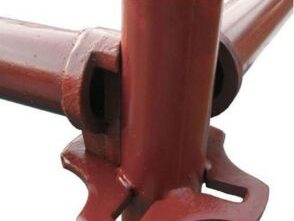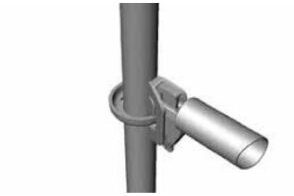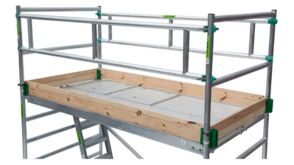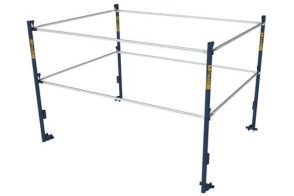System scaffolding consists of pre-engineered components that are fitted together to create a framework without steel fittings. This framework comprises vertical standards, horizontal ledgers, and diagonal bracing to create a stable and secure structure. Transoms are an essential part of the platform as they distribute loads evenly while ensuring efficiency in construction.
The main benefits of system scaffolding are quick assembly, high load-bearing capacity, reduced waste, and lost material. The main types of system scaffolding are cup lock scaffolding, crab shoring system, ring lock scaffolding, and quick lock scaffolding. The main uses of system scaffolding are in building construction, repair and maintenance, demolition support, painting, and decoration.
Table of Contents
What is System Scaffolding?
System scaffolding is designed with pre-engineered and modularized components that don’t need steel fittings for connection, as all the elements are interlocked to create a temporary structure. It’s like different parts of a jigsaw puzzle; you can combine them to make a puzzle. This temporary structure is useful for projects with tight deadlines as it offers quick and error-free assembly; all standard components can be assembled in an intricate structure without any mistakes or confusion.
Besides, workers experience comfort while working on a system scaffolding platform because this platform doesn’t have any ledger brace and has a clear continuous path to use. System scaffolds have robust construction and are considered the best choice for heavy-duty applications. The precise-locking mechanism and anti-slip platforms are two noteworthy safety features of system scaffolding. Besides, investment in this type of scaffolding brings a return in the long term for buyers due to its durability and re-usability features.
What is the Diagram of System Scaffolding?

System Scaffolding Images


What are the benefits of system scaffolding?
The six benefits of system scaffolding are as follows:
- Speedier Assembly and Dismantle Time
- Less Complex Training Required for Operatives
- Higher Load Bearing Capabilities
- Reduced Waste and Lost Material
- Better Overall Working Platform for Trades
- Clearer Visibility for Weekly Inspections
1. Speedier Assembly and Dismantle Time
The most significant benefit of system scaffolding is quick assembly and disassembly. Its pre-engineered components allow you to assemble the complete system efficiently and quickly. It doesn’t require intricate part fitting, as happens in the case of traditional scaffolding design. You can create the whole framework by combining its various prefabricated components. This quick assembly and dismantling function save labour time.
2. Less Complex Training Required for Operatives
Another plus point of system scaffolding is that the training process for operatives will be pretty straightforward. Its advanced design comprises a few components that make the setup and dismantling process easy to understand. In the case of a traditional scaffold setup, workers need to understand many different parts, and the risk of human error is high during assembly. In the case of system scaffolding, fewer training sessions are required to get a complete understanding of assembly and safe working conditions. Since the setup is pretty simple, the risk of human error is also reduced.
3. Higher Load-Bearing Capabilities
Another advantage of system scaffolding is its superior load-bearing capacity made possible through its highly durable pre-engineered components. The construction of each element is robust. The overall system is designed so that the load is distributed evenly. Since it can bear heavy loads, therefore it is commonly used to support heavy-duty materials.
4. Reduced Waste and Lost Material
Another benefit of using system scaffolding is its reduced waste and lost material. Traditional scaffolding has many components that usually get lost or damaged during the assembly and dismantling process. But this scenario is different from system scaffolding. It has standard and durable components that don’t get lost on-site. Thus, system scaffolding is an environment-friendly option that reduces waste and contributes to cost savings.
5. Better Overall Working Platform for Trades
System scaffolding has a consistent structure that decreases gaps and doesn’t lead to uneven surfaces. As a result, workers get a more stable platform on which to perform their work tasks with ease. This stable platform also contributes to workers’ overall productivity.
6. Clearer Visibility for Weekly Inspections
Weekly inspections are required for the scaffolding to ensure that it is safe for workers use.The biggest plus of system scaffolding is that it has a uniform structure with clear visibility. The modular nature of this scaffold allows inspectors to easily pinpoint areas where repair or maintenance needs to be done. Using system scaffolding for your construction site is a good idea as inspectors can easily inspect issues and address them. It’s how you can prevent accidents and stay compliant with safety regulations.
What are disadvantages of System scaffolding?
The five disadvantages of system scaffolding are as follows:
- High Initial Cost
- Complex Design Requirement
- Not Flexible and Adaptable
- Requires Skilled Labor
- Maintenance Needs
1. High Initial Cost
The biggest drawback of system scaffolding is its significant upfront cost. Pre-engineered components cost more than traditional counterparts. This high investment is a major barrier for contractors working on small projects with limited budgets.
2. Complex Design Requirement
Another issue with system scaffolding is that its initial setup requires detailed planning. Without this planning, the structure can be designed according to specific project requirements, and optimal use of the framework becomes impossible. Complex design requirements are a common challenge that contractors face when they decide to choose system scaffolding.
3. Not Flexible and Adaptable
The biggest drawback of system scaffolding is that it is not flexible and adaptable. Other types of scaffolding, such as tube and coupler scaffold systems, are highly flexible. You can easily change the framework for irregular structures and unconventional designs. But when it comes to system scaffolding, you can’t customize it to make it suitable for different scenarios.
4. Requires Skilled Labor
Another drawback of system scaffolding is that it requires skilled labour. Although its assembly is simple, only trained and experienced workers can handle this task precisely. To stay compliant with safety standards, you need to hire trained professionals to handle this specific project. Hiring skilled labour means incurring more costs.
5 .Maintenance Needs
To keep the whole framework in optimal condition, the pre-engineered components need to be regularly maintained. Inspectors need to perform weekly inspections and check the components for wear, tear, or corrosion. System integrity can be compromised if periodic inspections and repairs aren’t done on time. This ongoing maintenance will eventually increase the project’s operational cost.
What are the Types of System Scaffolding?
The seven types of system scaffolding are as follows:
- Ringlock scaffolding
- Cuplock scaffolding
- Quick Lock scaffolding
- Crab Shoring system scaffolds
- Tube Lock scaffolding
- Kwikstage
- OCTO® Scaffolding
1. Ringlock scaffolding:

Ringlock scaffolding consists of rings and horizontal braces. It contains a central connector placed on the vertical posts, where horizontal components are locked through rotational movement. This robust and versatile system scaffolding is easy to assemble and proves effective for heavy loads and complex geometric structures.
2. Cuplock Scaffolding:

Cuplock is the most popular type of system scaffold featuring a unique locking mechanism; nodes are locked through a system of cups. Its lower cup remains fixed in its place while the upper cup is moveable. When it rotates, it secures the components at its exact place. Cuplock scaffolding is super helpful for projects with high-loading bearing capacity.
3. Quick Lock Scaffolding:

Quick load scaffolding uses a simple locking system that allows rapid deployment of the system scaffold. It is easy to erect and dismantle this structure. This specific type intends to make overall scaffolding assembly quick and intuitive.
4. Shoring System Scaffold:

The crab shoring system comprises a unique diagonal brace locking system that establishes a secure framework. This type of system scaffolding is useful for heavy-load projects such as industrial buildings and bridges.
5. Tube Lock Scaffolding:

Tube lock scaffolding consists of tubes and locking devices. It offers excellent flexibility during assembly and configuration. This type of system scaffolding proves super effective in areas where traditional scaffolds are impractical.
6. Kwikstage Scaffolding:

Kwiskstage scaffolding is another common type of system scaffolding. It comprises pre-manufactured or modular structural components attached or stacked to create a scaffold. It’s lightweight, easy to assemble and disassemble the structure and provides flexibility for various structures. However, it’s not super durable like other kinds of system scaffolding.
7. OCTO® Scaffolding:

OCTO scaffolding has the most extended bay length, fewer components needed to assemble, and a unique locking mechanism that tightens with use. It provides many customization options for complex dimensions.
What are the uses of System Scaffolding?
The seven uses of system scaffolding are as follows:
- Building Construction
- Repair and Maintenance
- Painting and Decorating
- Window Cleaning
- Demolition Support
- Tight or Narrow Spaces
- High-Rise Buildings
1. Building Construction

System scaffolding is mainly used for building construction. It provides a temporary stable platform for bricklayers, carpenters, and other workers. This framework has a high load-bearing capacity, facilitating the installation of different structural elements of a building, such as panels, beams, and columns.
2. Repair and Maintenance

Another common use of system scaffolding is in repair and maintenance tasks. Sometimes, inspectors find cracks, leaks, or other structural issues in a building. In that case, system scaffolding is used to fix these structural issues. It is quite useful in replacing balconies, ledgers, and cornices.
3. Painting and Decorating

System scaffolding provides a stable platform for painters and decorators to complete tasks easily. The best thing about this scaffold is that it offers a secure platform, so even when painters and decorators need to work at great heights, they can do that without experiencing any setbacks or accidentalfalls. Painting walls, ceilings, and facades become effortless through this scaffolding.
4. Window Cleaning

When cleaning high-rise buildings or multi-story sites, system scaffolding provides a safe and stable surface that cleaners can use. They can keep all the cleaning tools on their platform and complete their cleaning task precisely at different heights. It offers safe access to cleaning large panels or windows. The use of system scaffolding reduces the risk of accidents that happen when workers rely on temporary solutions or ladders.
5. Demolition Support

System scaffolding proves useful during demolition support as it acts as a temporary structure that workers can use when dismantling floors, ceilings, and walls. It provides excellent support, especially when heavy material needs to be removed in a controlled and efficient manner from a construction site. In addition, it also protects workers from debris that falls from the building during the demolition process.
6. Tight or Narrow Spaces

System scaffolding is designed with prefabricated pieces confined to narrow and tight spaces. So, if your construction tasks have to be done in limited spaces, alleys, or corners, traditional scaffolding is never suitable. In this scenario, contractors can rely on system scaffolding. Its strong construction offers safety and stability in challenging environments for workers.
7. High-Rise Buildings

System scaffolding is quite useful during the construction, maintenance, and inspection of high-rise buildings. Workers can access varied levels of the building through this temporary structure. It has an advanced locking mechanism and other safety features that allow workers to continue working at elevated levels without facing any risk of falling or other accidents.
What are the Parts of System Scaffolding?
The twelve parts of system scaffolding are as follows:
- Standards
- Ledgers
- Transoms
- Bracing
- Base Plates
- Platform/Decking
- Couplers
- Toe Boards
- Guard Rails
- Sole Boards
- Clamps
- Ties
1. Standards

Standards are the vertical poles in the system scaffolding framework. They provide main support to the structure and distribute the overall load throughout the structure evenly. Standards have holes and notches that serve as connection points for other components.
2. Ledgers

Ledgers are horizontal tubes that serve as support beams for platforms and transoms. They enhance the structural integrity of system scaffolding while acting as a connection point for braces and decking.
3. Transoms

Transoms are horizontal components that are installed at right angles to ledgers and they provide ultimate support to planks or work decking. They enhance the stability of system scaffolding while maintaining the width of the overall structure.
4. Bracing

Bracing are diagonal components of the system scaffolding, they are also known as diagonal scaffold ledgers because they stiffen and stabilize the scaffold. They provide additional strength to both vertical and horizontal frames and prevent them from collapsing. Braces are quite useful parts of system scaffolding as they enhance the resistance of this framework against external forces like winds and vibrations.
5. Base Plates

Base plates are flat places usually attached to the bottom of standards. They don’t let the standard sink in the round and distribute the overall weight of the scaffold throughout the foundation. They offer a stable base to the system scaffold.
6. Platform/Decking

Platforms are horizontal surfaces where workers stand and place all the tools and materials. They are like the working area of a system scaffold that workers use for repair, construction, and maintenance tasks. Platforms or scaffold decks are usually made of metal or wood and they provide excellent support to the weight of workers, tools, and materials.
7. Couplers

Couplers are connectors that are used to join scaffold tubes and components together. The best thing about this part of the scaffolding system is that it brings flexibility to the design. It allows workers to assemble scaffolds in varied configurations. They add to the overall strength of the system scaffolding’s joints.
8. Toe Boards

Toe boards are horizontal boards that are installed on the platform’s edges. They prevent material, debris, and tools from falling off the platform or causing injury to ground workers or pedestrians. They act as a boundary that keeps workers within the platform area.
9. Guard Rails

Guardrails are essential safety parts of system scaffolding. They are horizontal rails installed at the platform’s edges and they prevent it from falling. It offers safety barriers for workers and protects them from accidental fall scenarios.
10. Sole Boards

Soles boards are wooden or metal-based boards that are used to stabilize scaffolds on soft and uneven ground. They prevent the structure from tilting or sinking by spreading the load from the framework to the ground. It also safeguards ground and flooring from damage.
11. Clamps

Clamps are mechanical devices that are used to secure components of a scaffold together. It is used to secure pipes, poles, and other parts together. Clamps ensure tight connections and provide flexibility for creating irregular scaffold setups. They are essential for adding strength to the most important joints of the structure.
12. Ties

Ties are used to secure scaffolding to permanent structures. It prevents structures from swaying and tipping and ensures safety for complex scaffolding setups and high-rise buildings.
What is the difference between system scaffolding and modular scaffolding?
Here is a table that describes the main points of differences between system scaffolding and modular scaffolding:
| System Scaffolding | Modular Scaffolding |
| A pre-engineered and reusable scaffolding with fixed components designed for quick assembly and dismantling, also known as prefabricated scaffolding. | A type of scaffolding system where Standardized components are arranged in different configuration |
| Has modular components that offer diverse configuration | Offers great flexibility in design and configuration, easily adaptable to various project needs |
| Suitable for straightforward projects like painting, construction, and maintenance | High flexibility, suitable for projects with varied configurations |
| Easier to assemble as it requires minimal customization and has pre-designed components | Difficult to assemble, requires careful planning and technical expertise due to customization |
| Has fixed components such as standards, ledgers, transoms, and decking | Suitable for complex projects such as unusual shapes, facades with varied height levels |
| Cost-effective, used for repetitive projects with efficiency | Limited flexibility, suitable for repeated projects with the same specifications |
| Safer, features with guardrails, toeboards, and other safety features | Expensive due to potential customization and component versatility |
| Quick assembly time due to pre-engineered components | Less safe, and has all the safety features but risk increases as it is often used in complex environments, though careful planning mitigates risk factors |
| Less safe, and has all the safety features but risk increases as it is often used in complex environments, though careful planning mitigate risk factors | Long assembly time as there is a need for customization |






